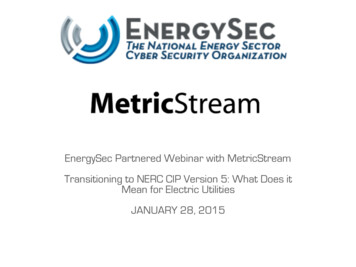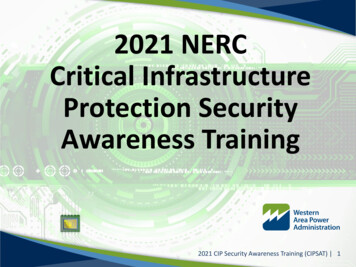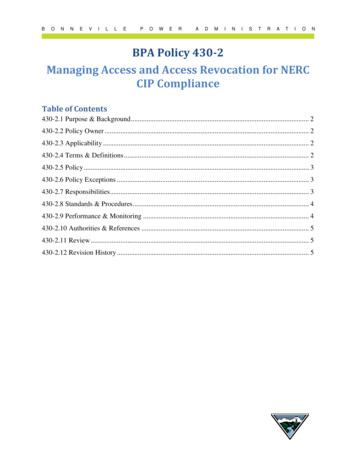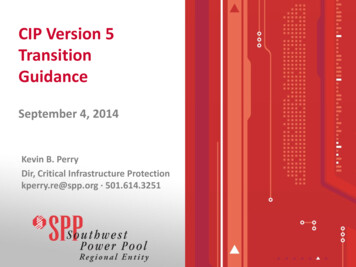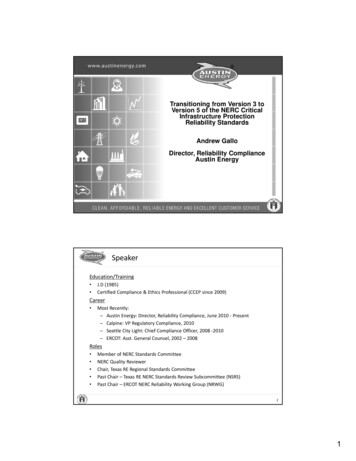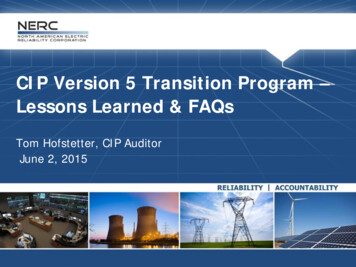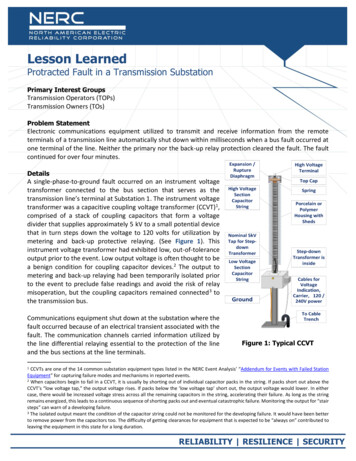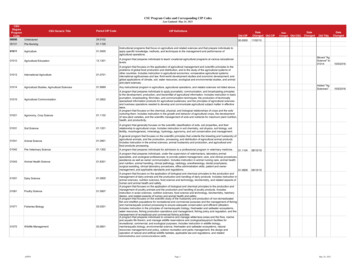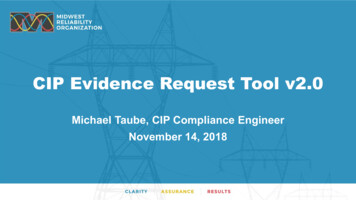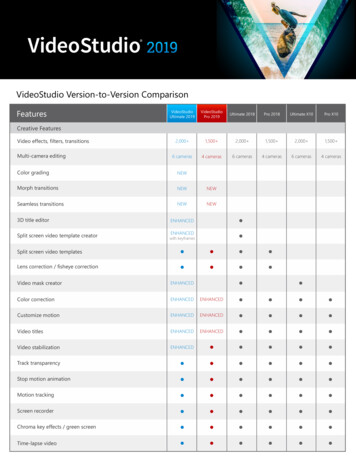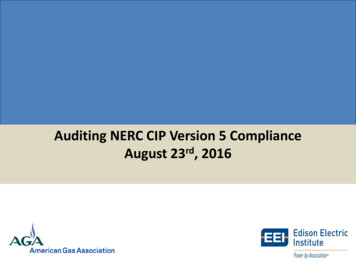
Transcription
Auditing NERC CIP Version 5 ComplianceAugust 23rd, 2016
Overview of NERC & The CIP Standards– Key Dates– High Level CIP overview Risk Based Compliance Monitoring & Enforcement– Developing and auditing a robust program Auditing The CIP Standards– Specific areas of focus for CIP-002 through CIP-011 Prepping For An Audit By RegulatorsAuditing NERC CIP Version 5 ComplianceAgenda2
Sean is the Manager for the Risk Management – Compliancearea for Dominion. Sean has been in that role for over 4 years and oversaw theNERC CIP v3 audit (with 0 findings) and the development ofour version 5 program. Dominion is in SERC, RF, NPCC and WECC. Dominion has Transmission (6,500 miles) and Generation(24,300 MW) We are integrated into PJM as the Balancing Authority and theTOP (Transmission Operator). In addition to NERC compliance, we also have TSA Pipelinewith 12,200 miles of Natural Gas transmission, gathering andstorage. We are also subject to PCI, SOx, NRC, CFATS, DODI, CoC, HIPAA.Auditing NERC CIP Version 5 ComplianceBackground3
Although often referred to as “version 5”, the current NERCstandards are a combination of v5, v6, v1 and v2 iterations onthe individual requirements. There are certain dates commonly talked about but there aresome exceptions to those dates that are noted in theImplementation Plan. The Implementation Plan also explains things such as when tobe compliant with unplanned changes after the effectivedates. Effective July 1st 2016, all High and Medium Impact BES CyberSystems had to be compliant with version 5 of the standards. Effective July 1st 2017, all Low Impact BES Cyber Systems haveto be compliant with a subset of the version 5 standards.Auditing NERC CIP Version 5 ComplianceKey NERC Version 5 Dates4
To obtain a complete list of the dates and copies of otherofficial documents we will talk about:1.2.3.Go to www.NERC.comClick on Program Areas & Development - StandardsOn the left side is a link to “One-Stop-Shop” From there you can scroll to the CIP section and obtain:–––––Copies of the current standard languageThe implementation planThe current version of the RSAW (Reliability Standard AuditWorksheet)Any Compliance Guidance or Lessons Learned that are availableEnforcement Dates and Retirement DatesAuditing NERC CIP Version 5 ComplianceNERC Website5
Unlike auditing for SOx or other regulatory requirements, the NERCstandards require utilities to prove compliance. A lack of proof of compliance means an entity is non-compliant. The adage of “If its not written down, it doesn’t exist” should beapplied to the program.– SME testimony is not generally sufficient to prove compliance movingforward.– Attestations can only be used to confirm you don’t do something becauseits not applicable. Don’t use them to assert you did do something. Proof of compliance needs to be maintained at least back to yourlast audit by your regulator.Auditing NERC CIP Version 5 ComplianceGuilty Until Proven Innocent– Check with your region(s) to ensure you adhere to their guidance. As an auditor, one way you can help your compliance programs isby reviewing their collection and retention of compliance evidence.6
There are 10 Standards, 33 Requirements and a combined 120Requirements Sub-Requirements to be compliant with.– CIP-014 is not included in this discussion. Many entities handle itseparately from the ‘core’ CIP standards.– A new “Supply Chain” focused standard will be coming that will addanother section to this list and may also be handled separate from thecore CIP standards by your entity. The standards are evolving.– Over the coming months official audit results will begin to occur whichwill be provide insight on how the standards are enforced.– Lessons Learned/Official Guidance will continue to be published andthat will evolve the understanding and enforcement.– The Standards Drafting Team is currently engaged in a number ofmodifications to the standards that we will learn more about later thisyear or early 2017. This will include a new Supply Chain standard.Auditing NERC CIP Version 5 ComplianceThe CIP Standards7
Auditing NERC CIP Version 5 ComplianceThe CIP Standards8
Originally termed “RAI” (Reliability Assurance Initiative) thereis an optional component to the CIP standards in version 5now known as the RBCMEP. The idea is that entities will assess their programs based onrisk - build controls for those areas of higher risk - monitorthose controls for compliance - periodically test thosecontrols to ensure they are working. The better an entity performs the RBCMEP role, the moreconfidence your regulator can have in your program. The more confidence they have, the less deeply they need todig during an audit. During the version 5 transition pilot, it was reported that goodcontrols programs could result in a 40% reduction in auditscope.Auditing NERC CIP Version 5 ComplianceRisk Based Compliance Monitoring & Enforcement9
One area that internal auditing can add value to a NERC CIPprogram is to participate in the RBCMEP effort. Since auditors are typically in a different organization, with adifferent goal structure, than the personnel primarilyresponsible for NERC CIP, their results can be value addedwhen attempting to demonstrate robust controls are in place. As auditors you are already familiar with what makes for agood control and with methods to test a control foreffectiveness. The idea behind a RBCMEP program is to both prevent impactto the Bulk Electric System by detecting incidents before theyhappen, and to build confidence in your regulator that you areeffectively doing that.Auditing NERC CIP Version 5 ComplianceRBCMEP Continued 10
Areas to focus on when evaluating the RBCMEP programinclude:– What is the Risk Based Methodology your entity used to risk rank theNERC CIP requirements? Is that methodology well defined? Can thecriteria be defended from an ‘auditor’ perspective?– For the areas of highest risk, were “good” controls identified? Goodcontrols: Don’t just restate the RequirementAre a blend of Preventative, Detective and CorrectiveAre repeatableAre effectiveAre verifiable– Are there both Entity level controls (ex: an enterprise system tomanage access?) and Activity level controls (ex: how group X ensuresthat all cyber security tests are accurately and completely performedbefore a change goes into production)?Auditing NERC CIP Version 5 ComplianceRBCMEP Continued 11
Areas to focus on when evaluating the RBCMEP program alsoinclude:– Is there audit quality evidence that shows the control was performed?If its not written down, it did not happen.– How do you know the controls are effective? Are they periodically tested to ensure they are working?Are they based on an industry standard?Are they automated so there is little change for human error?Can the regulators reasonably conclude that the controls are workingeffectively. While the RBCMEP is both optional and nebulous, it is an area theregulators are very interested in. An investment in this area canreap rewards both in terms of reducing Self Reports and reducingyour audit scope. As auditors, you have a value added perspective to thedevelopment of your entities RBCMEP program.Auditing NERC CIP Version 5 ComplianceRBCMEP Continued 12
Certain standards are inherently more risky than others.– Some rely on a high degree of Human Performance to besuccessful.– Some, if failed, pose a significant risk to the Bulk Electric System.– Some already have complexities and/or subtleties in theirguidance from regulators that should be accounted for. The intent of the following slides is to provide key areas toreview during an internal audit of your CIP program. This is not intended to be a comprehensive overview of all120 Requirements/Sub-Requirements.Auditing NERC CIP Version 5 ComplianceAuditing The CIP Standards13
This standard is the under-pinning of your entire CIP program. The largest fines for CIP violations happen when a CIP-002execution is flawed. Under version 5, CIP-002 will ‘bucket’ your assets into High,Medium and Low classifications. Based on that classification, some or all of theRequirements/Sub Requirements will need to be applied. CIP-002 was ‘simplified’ under Version 5 to remove the needto develop & maintain a methodology. Instead, a series of objective criteria are applied to all assetsfrom a specific list such as Control Centers, TransmissionSubstations and Generation resources.Auditing NERC CIP Version 5 ComplianceCIP-002-5.114
Show Your Work– Although the results matter, entities must show how they achievedthose results to pass an audit by the regulators.– Evidence that the entire population of assets was considered must beretained. Misuse– One of the subtleties of this standard is the idea of ‘misuse’ as itapplies to supporting systems (such as your Patch Managementsystem).– Show the work that documents that all systems were evaluated.– Show the proof (vendor documentation? Firewall rules?) that proves asystem cannot be misused to impact the BES within 15 minutes.Auditing NERC CIP Version 5 ComplianceCIP-002 continued There is no such thing as “No Impact”15
This standard is much more brief than under version 3. Major components were moved to CIP-010 and CIP-011. Primarily it revolves around having Policies (signed by the CIPSenior Manager) that govern your program and protectingLow Impact assets. Low Impact protections do not need to be in place until7/1/2017 and include:Ensure your policies address LowsHave a Security Awareness Program at LowsHave Physical Access Controls at LowsRestrict electronic access where devices are network accessible ordial-up accessible– Ensure your Incident Response Plan addresses Lows––––Auditing NERC CIP Version 5 ComplianceCIP-003-616
Areas to focus on during an internal audit include:– Review proof that a Quarterly Security Awareness message wasprovided to all personnel with authorized electronic or authorizedunescorted physical access to BES Cyber Systems. It is NOT necessary to prove personnel reviewed the materials.– Training must be provided prior to gaining access and at least every 15calendar months. Evidence should show this.– Training must be ‘appropriate’ to individual roles, functions orresponsibilities. Therefore evidence of what those ‘roles’ are and howyou classify personnel into them should exist.– Ensure your training program covers all 9 topics/areas, for allpersonnel, as outlined in Requirement 2.1.– Review your Personnel Risk Assessment Program against the R3 subrequirements to ensure all required elements are captured.Auditing NERC CIP Version 5 ComplianceCIP-004-617
Areas to focus on during an internal audit also include:– Review the process used, every calendar quarter, to ensure thatAccess that has been given has a corresponding Authorization record.– Review the process used, at least every 15 calendar months, to ensurethat the electronic access that exists is the correct access.– Access Removal has changed significantly under Version 5 and was oneof the most commonly failed standards under Version 3. Evidence should exist that physical and interactive remote access wasremoved within 24 hours of any termination access (including retirementsand voluntary departures). This is 24 hours not a calendar day and weekends/holidays count. Evidence should exist that for reassignments or transfers, access that isno longer necessary was revoked by the end of the next calendar day. Evidence that access to ‘information’ was removed by the end of the nextcalendar day for all terminations. There are additional ‘30 day’ removal requirements that can be checked.Auditing NERC CIP Version 5 ComplianceCIP-004-6 continued 18
Areas to focus on during an internal audit include:– What evidence is there that ALL applicable Cyber Assets, connectedvia a routable protocol, reside within an Electronic Security Perimeter(ESP)? Some regions are interpreting serially connected relays as needing to beclassified within the ESP. Check with yours.– All ESPs, need an EAP (Electronic Access Point) through which allExternal Routable Connectivity (ERC) passes. Typically this is a Firewall. How does your organization define it and doesevery ‘breach’ in the ESP perimeter have an associated device?– Check for Dial-Up connectivity. Is that exists (ex: a modem in asubstation allowing remote connectivity to a communicationsprocessor), R1.4 applies or a TFE needs to be filed.– Is there evidence that all Interactive Remote Access sessions utilize anintermediate system? (i.e. do you have, perhaps, a Jumphost runningsomething like Citrix, that your remote personnel use to access BES CyberSystems/Assets). Ensure there is no direct interactive connectivity through the Access Point.Auditing NERC CIP Version 5 ComplianceCIP-005-519
Areas to focus on during an internal audit include:– Review the Physical Security Plan. Under version 3 different rules applied (i.e. a 6 walled border wasrequired). Under version 5 the plan must include “controls to restrict physicalaccess.” What evidence exists that your plan will restrict access that utilizes atleast 1 physical access control (for Medium Impact) and 2 or moredifferent physical access controls (for High Impact)?– Monitoring, Alerting and Logging of various things are required. YourPACS (Physical Access Control Software) likely handles this butevidence could be reviewed.– When wiring leaves the PSP, is it protected? If not, are the allowedelectronic controls in place? (R1.10)Auditing NERC CIP Version 5 ComplianceCIP-006-620
Areas to focus on during an internal audit also include:– Review evidence that all visitors had continuous, escorted accesswhenever they were within a PSP. Often this is a log showing the person was signed in and ‘escorted’ by anauthorized individual and a procedure stating that person mustcontinually escort them while inside the PSP.– Ensure logging occurred for all visitor entry into and exit from the PSP. If you have a location with multiple PSPs (perhaps multiple control housesat a substation or multiple secured areas within a power plant), how didyou log the visitors into each of those? Or was logging only done at themain gate?– Review evidence of Maintenance and Testing (every 24 months) ofeach PACS and locally mounted hardware.Auditing NERC CIP Version 5 ComplianceCIP-006-6 Continued Don’t forget about things such as the magnetic locks that you likely haveon the doors.21
Areas to focus on during an internal audit include:– A list of necessary ‘logical network accessible ports’ will exist. Review the evidence that the ports are deemed necessary.– Review evidence of how the physical ports (such as a USB port) on theBES Cyber Assets are protected. This may include Port Locks or Signage or they may be logically disabled.– Patch Assessment was a highly failed requirement under version 3.Under version 5 it becomes more complex since patches now need tobe applied as well. What are your Patch Sources? Are those sources reasonable ones suchthat your entity would learn about important security patches? Review evidence that all security patches were tracked and ‘evaluated’(for applicability) at least once every 35 calendar days. Review evidence that the patches were applied within 35 calendar days ofbeing ‘evaluated’.Auditing NERC CIP Version 5 ComplianceCIP-007-622
Areas to focus on during an internal audit also include:– If a Mitigation Plan (MP) was created, in place of applying a patch, thatMP needs to include specific actions that address the vulnerabilitieswithin that security patch (i.e. an entity cannot just have a genericstatement for all MPs that reads that they have a firewall therefore no one canreach the asset therefore the risk is mitigated).– Review evidence that ‘events’ are being logged at the BES CyberSystem level per R4.1. Are those events triggering alerts if detected?– For your High Impact locations, every 15 calendar days a method mustbe used to see if there were any undetected Cyber Security Incidents(sampling or summarization is acceptable).– Review evidence that access to ‘Shared Accounts’ is tracked. Whoknows the password? What do you do when someone leaves thegroup who knows the password? There are other requirements in CIP-007 that could be sampled andreviewed. These were some of the more common challenge areas.Auditing NERC CIP Version 5 ComplianceCIP-007-6 Continued 23
This standard is all about your Cyber Security IncidentResponse Plan. The Version 5 requirements are very similar to the Version 3requirements. If you had a strong program under v3 then youare likely in good shape under v5. Generally this does not require much effort to review and isrelatively low risk. Some areas to consider reviewing are:– Does your plan “identify, classify and respond” to incidents? - Planssometimes start by assuming an incident was already identified andthus fail to include that component.– Are the roles and responsibilities of involved groups clearly defined?– Have you ever had an incident? If so, records must be retained.– Is the plan being tested at least every 15 calendar months?Auditing NERC CIP Version 5 ComplianceCIP-008-524
This standard is about recovering your asset. The key to CIP009 is having a “technical recovery plan” that has sufficientlevel of detail that a ‘mid level’ technical person could follow itsuccessfully.– One way to think about that is to ask the question: If you had anemergency and brought in trained personnel from another companyand handed them your procedure, could they follow it, without anyadditional help or guidance, and recover your asset?– If not, then there is not enough technical detail in the procedure.– Does your plan include the ‘conditions’ that would cause it to beactivated?– Are the roles and responsibilities clearly defined?– Is there a process to verify SUCCESSFUL backups? And fix unsuccessful?– Is the plan tested at least every 15 calendar months?– Is an actual recovery done every 36 months for High Impact assets?Auditing NERC CIP Version 5 ComplianceCIP-009-625
Under version 3, configuration and change management waslargely limited to CIP-003 R6 which required entities to “controlchange”. Under version 5, the requirements are much moreexplicit and related requirements are consolidated into CIP010. Areas to focus on during an internal audit include:– There will exist a “baseline”. Does it contain all the elements in R1.1? Custom Software is inclusive of “scripts” your entity has written. Guidance from our lead region (who said NERC and the other regionsconcur) is that ALL custom scripts must be included even if they justgenerate a report or run a WinAudit scan.– Is there evidence that all changes to the baseline are “authorized” and“documented”?– Is there evidence that PRIOR to the change being implemented,impacted cyber security controls were identified?Auditing NERC CIP Version 5 ComplianceCIP-010-226
Areas to focus on during an internal audit also include:– FOLLOWING the change (i.e. in Production), is there evidence that thosecyber security controls are not adversely affected?– For your High Impact systems, were the changes tested in a testenvironment? (or if they were tested in production, was it done in a wayso as to minimize adverse effects such as doing them on a fail overserver first?)– What evidence is there that at least every 35 days your High Impactsystems were monitored to detect changes in their baseline?– Vulnerability Assessments are largely the same under version 5 but achange is that an ‘active’ scan needs to be performed every 36 monthsfor High Impact systems.– If your environment uses Removable Media (i.e. USB drives) orTransient Devices (i.e. a laptop your technicians bring around tosubstations) there are requirements in CIP-010 Attachment 1 that needto be adhered to. Audi
CIP-002 was ‘simplified’ under Version 5 to remove the need to develop & maintain a methodology. Instead, a series of objective criteria are applied to all assets from a specific list such as Control Ce
